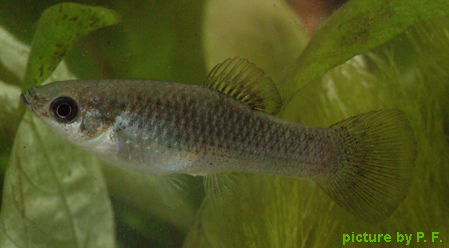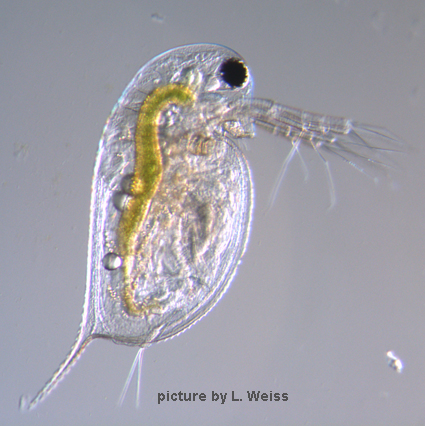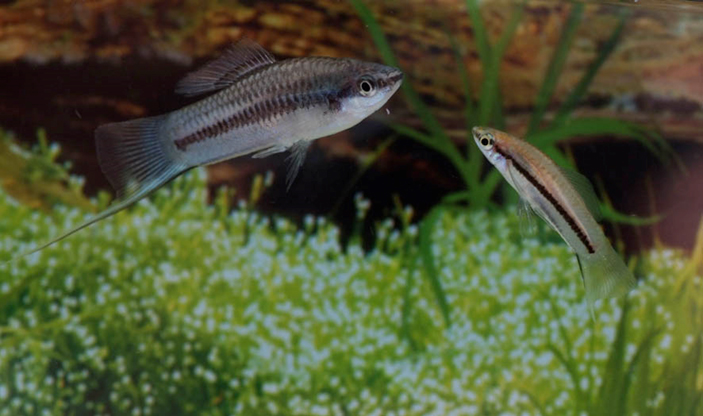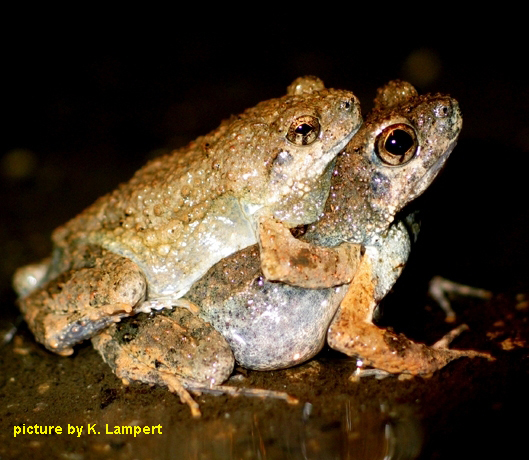Research projects
I am interested in the evolution of sex and in the genetic basis of behavior and ecology. I favor an integrative approach of research that includes phenotype and genotype (and gene expression).
I use several different animal model systems for different aspects of my work:

The Amazon molly - Poecilia formosa
My main model studying the evolution of sex is the Amazon molly, Poecilia formosa. It is an all-female hybrid species and reproduces gynogenetically ,i. e.,
it produces unreduced diploid eggs but needs sperm from a closely related sexual species to trigger the onset of embryonic development. Usually, the male genetic material is excluded from the oocyte and does not contribute to the offspring (clonal reproduction). In very rare cases, however, this exclusion mechanism
it produces unreduced diploid eggs but needs sperm from a closely related sexual species to trigger the onset of embryonic development. Usually, the male genetic material is excluded from the oocyte and does not contribute to the offspring (clonal reproduction). In very rare cases, however, this exclusion mechanism
fails leading to paternal introgression of genetic material in the form of micro-
chromosomes or triploidy.
Clonal vertebrates are generally thought to be evolutionarily young and due to the lack of recombination very vulnerable to accumulation of mutations. There is, however, evidence that despite its clonal reproduction P. formosa is much older than expected and that in general clonal vertebrates might be rare because the genetic prerequisites for them to occur are rare not because they have a fitness disadvantage (Lampert et al. Curr. Biol. 2007, Stöck, Lampert et al. Mol. Ecol. 2010). We investigate whether the rare inclusion of male genetic material in form of an additional genome benefits P. formosa by adding to their genotypic variability probably compensating for mutations. Current projects include a P. formosa "remake" and determination of mutation rates using microsatellites. In addition, long and short term population genetic studies using microsatellites are a major part of the project.
In the context of the evolution of sexual reproduction I am very interested in the Red Queen hypothesis and therefore in host-parasite/pathogen interactions. Therefore, I study interaction in the Amazon molly system at very different levels. Amazon mollies act as sperm parasites but are also host to pathogens. I compare MHC variability within Poecilia formosa as well as among P. formosa and its parental species: Poecilia mexicana and Poecilia latipinna (Lampert et al. Mol. Ecol. 2009). To study the immune genes in more detail I became a member of the Amazon molly genome consortium and I am now analyzing full genome data of P. formosa from several field sites.
chromosomes or triploidy.
Clonal vertebrates are generally thought to be evolutionarily young and due to the lack of recombination very vulnerable to accumulation of mutations. There is, however, evidence that despite its clonal reproduction P. formosa is much older than expected and that in general clonal vertebrates might be rare because the genetic prerequisites for them to occur are rare not because they have a fitness disadvantage (Lampert et al. Curr. Biol. 2007, Stöck, Lampert et al. Mol. Ecol. 2010). We investigate whether the rare inclusion of male genetic material in form of an additional genome benefits P. formosa by adding to their genotypic variability probably compensating for mutations. Current projects include a P. formosa "remake" and determination of mutation rates using microsatellites. In addition, long and short term population genetic studies using microsatellites are a major part of the project.
In the context of the evolution of sexual reproduction I am very interested in the Red Queen hypothesis and therefore in host-parasite/pathogen interactions. Therefore, I study interaction in the Amazon molly system at very different levels. Amazon mollies act as sperm parasites but are also host to pathogens. I compare MHC variability within Poecilia formosa as well as among P. formosa and its parental species: Poecilia mexicana and Poecilia latipinna (Lampert et al. Mol. Ecol. 2009). To study the immune genes in more detail I became a member of the Amazon molly genome consortium and I am now analyzing full genome data of P. formosa from several field sites.

Waterfleas - Daphnia pulex
Because of their dual reproductive mode (clonal as well as sexual cycles) and the great knowledge about their ecology waterfleas are a very interesting group to study the evolution of sex. More specifically I am interested in population genetics and ecological performance differences of clonal and sexually produced individuals. My Daphnia research includes investigating clonal erosion due to predation pressure in an over-wintering Daphnia population (Lampert et al. Freshwater Biology 2014). Future studies will include genomic approaches (RADtag) to identify genes involved in predator response and reproductive mode.

Genetic basis of phenotypic polymorphisms
I am interested in the reproductive behavior of a parthenogenetic crayfish (Procambarus spec.). This crayfish was reported to reproduce clonally. I am currently trying to confirm this statement with molecular methods and to further characterize the reproductive mechanism.

Túngara frogs - Physalaemus pustulosus
Tungara frogs are famous model organisms for studying sexual selection and the evolution of communication. In co-operation with Michael J. Ryan from the University of Texas at Austin, I am investigating the genetic, phenotypic and acoustic variation of island populations of túngara frogs. I am also looking at heritability of male mating call traits in these frogs.

Other projects
As I am interested in genotypic variability and population connectivity I am also conducting a number of population genetic and paternity studies on a variety of different organisms.
For example, I am conducting several studies on population genetics and intracolonial genetic variability in scleractinian as well as fire corals that include 454 sequencing as a fast method to identify
For example, I am conducting several studies on population genetics and intracolonial genetic variability in scleractinian as well as fire corals that include 454 sequencing as a fast method to identify
microsatellite markers but also enables us to construct the full mitochondrial genome that will be used for deeper phylogenetic analyses. In the future we are planning to use full genome approaches (RADtag) to identify genes involved in calcification, reproduction and local adaptation (growth form, reproductive mode, pathogen resistance).
I am also studying the colour polymorphism and interaction with symbionts in the upside down jellyfish, Cassiopea. Another project includes population dynamics and connectivity of East African Latimeria populations (Lampert et al. Curr. Biol. 2012, Lampert et al. Nature Comm. 2013). I have also started a co-operation with the LANUV to study the origin of the re-established salmon populations in different rivers in NRW. With the Landesfischereiverband Westfalen & Lippe I am working on the conservation genetics of the highly endangered Quappe (Lota lota). I am also interested in the reproductive behavior of a parthenogenetic crayfish (Procambarus spec.) a potential threat to the native German limnofauna.
I am also studying the colour polymorphism and interaction with symbionts in the upside down jellyfish, Cassiopea. Another project includes population dynamics and connectivity of East African Latimeria populations (Lampert et al. Curr. Biol. 2012, Lampert et al. Nature Comm. 2013). I have also started a co-operation with the LANUV to study the origin of the re-established salmon populations in different rivers in NRW. With the Landesfischereiverband Westfalen & Lippe I am working on the conservation genetics of the highly endangered Quappe (Lota lota). I am also interested in the reproductive behavior of a parthenogenetic crayfish (Procambarus spec.) a potential threat to the native German limnofauna.
| Letzte Änderung:24.03.2015 | Ansprechpartner/in: Kathrin Lampert Tel.: 02 34 / 32 2 55 73 |

